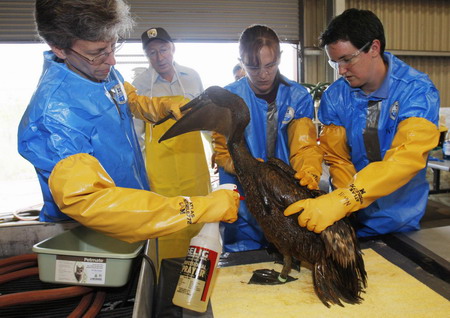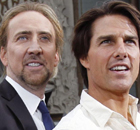Asia-Pacific
US presidential commission to probe oil spill
(Agencies)
Updated: 2010-05-18 09:55
 |
Large Medium Small |
|
 US Secretary of the Interior Ken Salazar (2nd L) watches as veterinarians working for US Fish and Widlife Services bathe an oil soaked brown pelican at Fort Jackson Wildlife Rehabilitation Center in Buras, Louisiana May 15, 2010. [Agencies] |
BP Chief Operating Officer Doug Suttles said the company hoped the siphon device could help contain half of the oil escaping from the well. It estimates that about 5,000 barrels (210,000 gallons/795,000 liters) are spewing forth.
"We're getting a little over a thousand barrels of oil a day up through that tube and over the course of today we'll be trying to increase that rate." he told reporters.
NOAA said that with light winds forecast from the south and the west in coming days, "ocean models indicate that any tar balls leading the southern edge of the plume could begin moving more to the south west and potentially into the loop current."
"We know that the oil has not entered the loop current at this time," Coast Guard Admiral Mary Landry told a briefing. "There may be some leading edge sheen that's getting closer to the loop current, but this spill has not entered the loop current proper."
BP's next move could involve a so-called top kill option undersea robots to try to shoot heavy "mud," a mixture of synthetic materials, into the blown-out well to form a barrier to prevent oil and gas from escaping.
This may be combined with a "junk shot" to inject material like golf balls and pieces of rubber tire, into the ruptured well's failed "blowout preventer" to seal off oil flow.
The disaster has hurt BP's image, already tarnished in the United States from a 2006 spill in Alaska from a BP-owned pipeline and 2005 fire at the company's Texas City refinery that killed 15 workers and injured 180.
A study released by the Center for Public Integrity showed two BP-owned US refineries accounted for 97 percent of all flagrant safety violations found in the refining industry by government inspectors over the past three years.
"The only thing you can conclude is that BP has a serious, systemic safety problem in their company," Jordan Barab, deputy assistant secretary of labor for occupational safety and health, was quoted as saying in a statement from the group.
"They're a big company. They'll probably change their name and start over," said Drake Dupre, 48, a Louisiana shrimp boat captain. "We've got one life. We can't start over again."
US lawmakers are studying raising a cap on corporate liability for oil spills, but Senate Majority Leader Harry Reid has rejected a proposed cap of $10 billion for oil companies to cover damages from oil spills as "inadequate."











